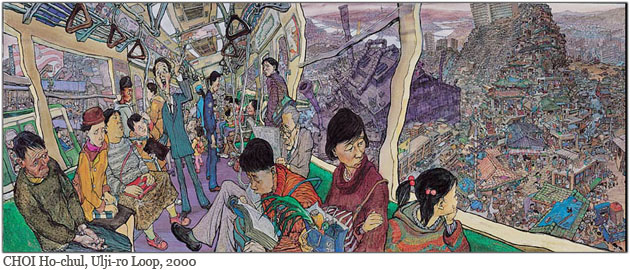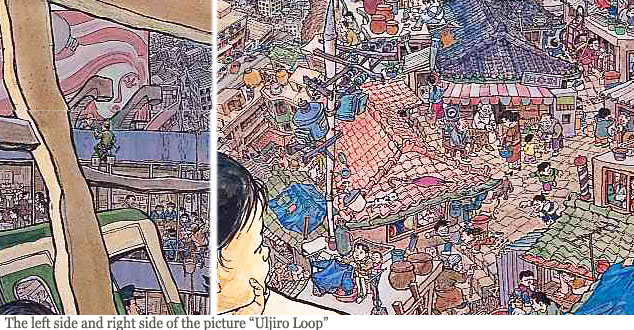
Written by Professor Jorg Michael Dostal, SNU Professor of Public Administration
So what is it like to live in Seoul? I get asked this question a lot by my European and North American friends. In answering it, I can respond lazily by comparing Seoul with places that they are more likely to know something about. Thus, I can say that Seoul is less crowded than Hong Kong, less anglicized than Singapore and less expensive than Tokyo. Yet that is really just a way of not answering the question.
In fact, it is very difficult to understand what defines Seoul. The city's variety of places, experiences and moods and the way each single place changes at different times of the day and during the dramatic shift from season to season makes one feel that time is the crucial single element to grasp the Seoul experience.
So what is Seoul time like? Most of all, there is never enough of it. Seoul is the city best suited for the nervous character. It appears to be a public duty for every proper Seoulite to feel stressed and exhausted at all times. There are certainly reasons to feel that way. Frequent commuting over large distances and long office hours provide many sources of pressure.
However, the inhabitants of Seoul are not just stress victims. Rather, they appear positively keen to invite stress into their life. It is typical to observe people engaging in 'multitasking'. The other day, I observed a girl passing me by on the SNU campus. I could not help noticing that she walked while carrying an open book, an open can of softdrink and was answering her mobile phone at the same time. Two hands, three tasks! I suppose that she conducted a conversation about how much she suffered from stress.
Thus, no matter how much people try to save time by engaging in multitasking, every day in Seoul conspires to be too short to get everything done. One needs tomorrow to catch up on what could not be finished today. So do the seasons pass. The current year appears rather short, certainly shorter than last year.
The connection between big cities and the shortage of time is of course as old as the experience of living in large cities. But Seoul pushes things further than every other place I know. How, then, can one try to explain the experience of living in Seoul to outsiders? Words certainly fail to sum it up. I did find an answer in a work of art. The masterful painting"Ulji-ro Loop" by Choi Ho-chul - exhibited in gallery four of the National Museum of Contemporary Art in Seoul - is to my mind what comes closest to summing up the experience of living in the Korean capital. I will explain why the painting captures the spirit of Seoul.
Seoul in Movement

The subject of the painting"Ulji-ro Loop" is in fact the Seoul metro itself, or rather the people using it. The painting shows the inside of a train compartment as well as the cityscape that the travellers on the metro can observe in looking out through the windows of the train compartment. In the centre of the painting we can see seven figures seated in the train section that is closest to the observer. From left to right, we see a middle-aged male drunk with sun-burned skin. He looks exhausted and stands for the element of suffering in the large city. Next to him two ladies are seated. The first lady is very slim, well-dressed and carries a small handbag while the second lady is of heavy stature, much more informally dressed and carries a large handbag. The slim lady looks concerned about sitting next to the drunkard while the heavily built lady looks exhausted, perhaps from having been engaged in physical labour earlier in the day. Right-hand side, we can observe an older man reading a newspaper. Everything about him, his suit, his shoes, his newspaper and his skin and hair are gray. He hides behind the paper and does not appear to be interested in his environment. Next to him, a male teenager listens to music on a headphone while starring at a thick book, possibly a textbook.
Last, we see a mother and her daughter. Both are well-dressed and the mother carries a bag of groceries. Behind the front group, we can observe other travellers in the background. The painting shows a businessman in a suit, a laughing teenager, a very slim security guard wearing his uniform, two exhausted office workers sleeping, an ajuma and a couple each travelling with a child and a slightly older student who appears to observe his fellow travellers (this figure is quite possibly the artist himself).
On the face of it, Choi Ho-chul's painting is not realistic. The characters shown here have some features of a cartoon or caricature. What we see here are 'archetypes' that we, as fellow travellers on the Seoul metro, are likely to encounter every day. In fact, as longer one looks at the painting, as more difficult it is to say whether or not this is a cheerful painting. Does it try making us feel good about how the metro makes us all mingle with each other or is the painting an example for social criticism? What speaks for the latter is that the characters in the painting look very exhausted, just as we feel exhausted in taking the metro during rush hour time.
A Painting of Seoul
The painting shows us travellers on the Seoul metro that look like a cartoon-like version of reality. I asked if the painting was cheerful - as the cartoon-like figures suggest - or whether the artist intends to offer social criticism.
The answer can be found in the cityscape that the left and right side of the painting shows us through the windows of the metro compartment in the center of the painting. On the left side, we see only gray buildings. One single large office building with three windows allows us to observe three different office scenes. In the first office, we see white collar workers seated in front of computer screens, in the second office blue collar workers being addressed by a supervisor, and in the third office people who seem to be engaged in some kind of supervisory or planning activity. What is important here is that all office workers in the painting have no individual features. The office environment has stripped them of their individuality and has turned them into different categories of"work soldiers."
That the artist is critical of this process is clear from looking at the right side of the painting. Here, we see a village-like environment in which all people, even the smallest ones in the background, have retained their own individuality. This section shows people's facial expression and their emotions in the finest detail. They associate freely with each other at home, in small shops, and in the streets. We can observe that the different generations live together while their children play happily in the streets. The artist shows us in effect an image of a glorified past in which the traditional village-like structures have survived. The picture appears to show a fairy tale environment of traditional folk stories rather than reality. That this way of life is going to disappear - indeed is being destroyed right now - is clear from the painting's background. Here, we see bulldozers busy in removing all traces of the old village and creating an empty space on which to build modern apartment buildings that fill the entire background of the painting.
The Essence of the Urban Experience
Is the painting a pessimistic vision of how the modern city of Seoul - the city of offices and apartments - takes away our individuality and our freedom?
So far I described the main features of the painting. We can see the inside of a metro compartment and some of the travellers on the metro. We also see the cityscape in which the metro is travelling. The artist shows us metro line number 2 travelling during daylight on some north-western corner of the circular line. This is, however, not realist art. The cityscape that features here, while showing some buildings in the background that exist in the real world, such as the National Assembly or the television tower, is not the cityscape of the Seoul we know. Rather, the cityscape on the painting has been made up by combining different artistic styles. The result is a collage that tries to give us the essence of the urban experience rather than reality. The spatial perspective of the painting is also confusing. The metro compartment appears more like a bubble rather than a solid structure. Is this really a metro train or rather a time machine that shows us travellers looking through the train windows onto the city's past outside?

One could interpret the right section of the painting - showing an abandoned industrial plant and a village - as standing for Korea's past when Seoul was an industrial city and labour migrants from the countryside brought their village culture to Seoul. However, the question of whether or not we see images of the past in the present is left open. Instead, the painting's focus is on the abundance of movement in the present. The painting shows a single unique moment that is not going to reappear.
The artist's intention, I believe, is to make us feel confused. Nothing in the painting is what it seems at first glance. We encountered a magic reality here, in which time and space have lost their conventional meaning. In fact,"Ulji-ro Loop" is neither a satirical version of reality nor is it a 'simple picture'. Rather, it becomes more complex and difficult to interpret the longer one looks at it.
Cheerful Social Criticism
The work is a major artistic achievement in at least two respects. First, the painting provides a magical vision of Seoul that questions viewers' perception of what is real. It casts doubt on our perception of time, space and of a course of history in which things happen in chronological order one after another. We become confused about what it is we are seeing. Is the painting celebrating modern Seoul and its dynamism or is it showing the urban landscape as a dystopia, a place where the dark side of progress destroys our common humanity?
Second, the artist invites us to make up our own mind about"progress." The painting shows the destruction of the past way of life. For example, the traditional village on the right-hand side of the picture is, the painting suggests, going to be destroyed by bulldozers. The new Seoul of high-rise apartment buildings in the background of the painting appears to suggest that a"Tower of Babel" is being constructed.
Evaluating the picture as a whole, we can conclude that the artist is not enthusiastic about today's Seoul. For example, the advertisements inside the metro compartment in the center of the painting are satirical and make fun of consumer capitalism. (For example, one of the advertisements shows a grinning fox that appears to advertise ladies cosmetics.) The little details of the painting are in fact full of satirical humour.
What Choi Ho-chul's painting does, I would finally suggest, is to provide us with cheerful social criticism. He expresses his concern about a society of endless work and endless consumption that takes over all our time and makes our life run according to rules beyond our control. However, his vision of Seoul provides some hope for the future, too. One of the children in the metro compartment in the center of the picture is smiling at us and the picture's satirical humour shows that the artist wants us to understand that he is also cheerful. Living in Seoul and the eternal shortage of time that the city's rhythm imposes on us - our lives virtually passing us by - is one side of the urban experience. On the other side, Seoul continues to offer us hope because the city's human energy will always clash with any attempt to impose technological control. Thus, Choi Ho-chul warns us of the dark side of the urban experience - but he also gives us hope that we will prevail. It is the cheerfulness and light touch of his social criticism that makes his painting stand out as the masterwork it is.

